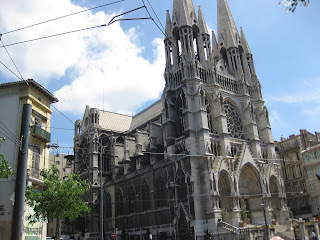5/21/10 et
seq.
I had essentially NO time during the organ tour to
record events and impressions, nor to finish writing about the Italy trip, so
I’ll try to do as much of that as possible on this train trip and for the
couple of days in London. I will fly out of Heathrow (God willing and the
ash-cloud doesn’t return) on Monday morning for Kiev. Hopefully, on that trip,
I’ll have more time to write as we ply Russia’s rivers and canals.
I’ll try to reconstruct the extraordinary tour of
the south of France (Le Midi) and its
marvelous organs from a few tidbits of journal entries, from photographs, and
from brief notes scribbled in the booklet for the tour: “Historic Organs of
Southern France,” May 9 – 21, 2010, with Michael Barone. American Public Media,
Pipedreams. I took lots of photos, and these should help refocus the memory.
 |
| Nave of Eglise Saint-Vincent-de-Paul |
 |
| Organ loft, Eglise Saint-Vincent-de-Paul |
The Pipedreams Organ Tour began in the shadow of the Icelandic
ash cloud for many of those on the tour, as had this whole trip for me. A few
of the participants couldn’t get air flights from Paris to Marseilles and had
to take the train. Others were delayed in London and arrived a day late in
Marseilles. I arrived the evening before most of the group in the city of Marseilles -
once the ancient Greek port of Massilia, and now the largest city of Provence
and the second largest city in France. I met Eddie, one of the trip regulars,
that first evening and we met again at breakfast.
 |
| Eglise Saint-Vincent-de-Paul, Marseilles, France |
It turns out that many of those on the tour (perhaps half of
them) are Michael Barone groupies and return year after year to visit organs in
various parts of the world (mostly Europe), to listen to them, often to play
them, and to enjoy one another’s idiosyncratic company and the chance to share a
passion for music in their own individualistic manner. There were 22 members of
the group (or 23, counting Lise Schmidt, Michael’s significant other of 32
years), as well as three leaders – Michael Barone, the host of Pipedreams on
Minnesota Public Radio (which airs on Sunday afternoons in Charleston); Janet
Tollund, who led our tour and usually organizes the Pipedreams tours (through
her tour company, Accolades), although she usually doesn’t lead the tour itself;
and Jean-Claude Guidarini, an accomplished organist from Toulouse, who was
apparently the major musical contact for the tour, who knew most of the
titular organists and organ builders, and who was usually the first person to
play the organ (sometimes after the titular organist) to show off its
possibilities with skilled improvisations.
 |
| Ancient fortifications above the harbor |
Eventually I came to realize that several of the churches we
visited had once been catholic cathedrals, converted to protestant churches. It was not always clear, however, which were which. Initially it
seemed that church (eglise) signalled a protestant church, and cathedrale (or abbaye or
basilique) indicated a catholic church, although, in retrospect, I’m dubious of
these distinctions. The south of France has had a complex and contorted
religious history, with the Albigensian heresy at the center of much
persecution and bloodshed, in addition to the Catholic schism with Rome during which
popes took up residency in Avignon, followed eventually by the protestant
reformation, which was bloody in this part of Europe – perhaps even bloodier
than elsewhere.

